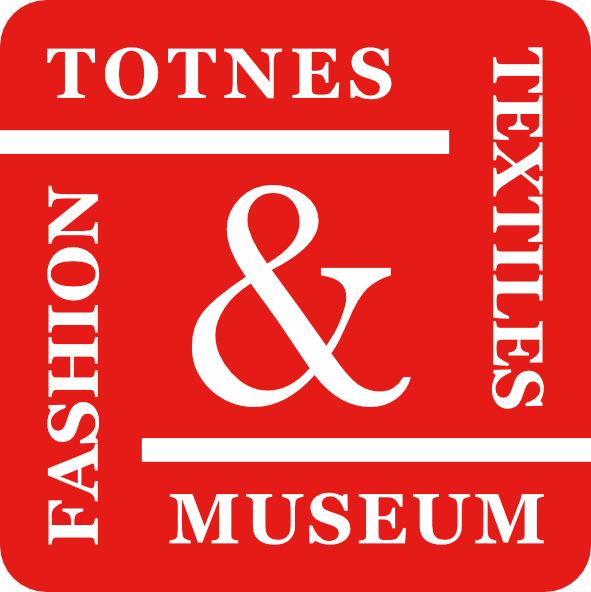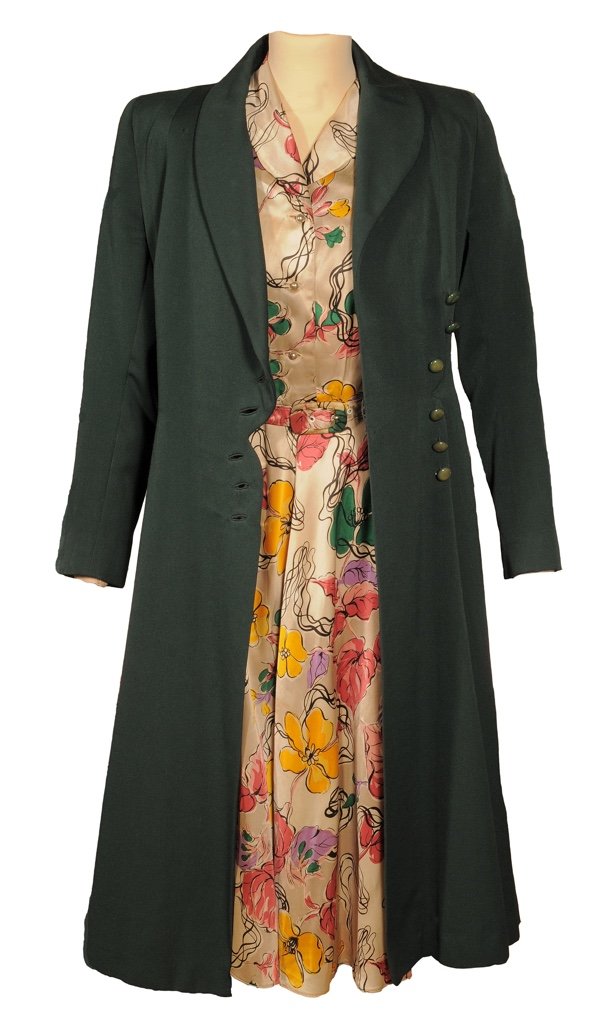Rationed Fashion: Utility and Wartime Chic
World War II food rationing was introduced in 1940 and the Utility scheme for clothing in 1941. The CC Utility mark was introduced in September 1941, starting with the cloth. Utility textiles and clothing were in shops 1942. There was no purchase tax on Utility clothing, whereas non-utility items had a tax of 66%.
c. 1943 yellow linen look printed rayon frock
Firms which complied with special conditions (minimum workforce 50) were “designated” by the Board of Trade to give them 75% or more of the production of clothing of general utility and had their female labour, including the 20 to 25 age group, protected from conscription to the forces. They would also receive most of the cloth allocated for civilian clothing. Non-designated firms could have their premises commandeered for more important war work.
Under the rules of Utility, ornamental stitching was banned as was steel and rubber – except for elastic in underwear. The number of buttons, use of pleats and width of sleeves, skirts and hems were curtailed. Men’s trouser turn-ups were eliminated as were double breasted jackets and pocket flaps. Patterns were designed to minimise cloth and labour. Shoes had to be made of leather. Crepe rubber soles, metal buckles and rubber adhesive were prohibited. Heels could be no higher than two and one eighth inches and made of wood without leather covering. After 1948 fabric uppers could be made within the scheme as well as slippers and house shoes.
Tom Heron, managing director of Cresta Silks, was asked to advise on women’s clothing in 1942. The Incorporated Society of London Fashion Designers was set up in 1942. Members were Hardy Amies, Bianca Mosca, Digby Morton, Peter Russell, Victor Stiebel, Worth and later Norman Hartnell. Each was asked to design and make prototypes for a topcoat, a suit and an afternoon dress all of Utility fabric and to conform to Utility regulations.
The number of coupons allocated per year varied during the war:
| 1941 | 66 | |
| 1942 | 48 | |
| 1943 | 47 | |
| 1944 | 46 | |
| 1945 | 41 | |
| 1946 | 52 | (because of the need for a “demob” suit, for those demobilised from the armed services) |
| 1947 | 50 |
As a consequence, by 1943 you could only buy one suit a year, so it was better to buy a more expensive one which would last longer.
In 1944 fur was added to the Utility scheme but this was not new fur until 1949. In 1946 wedding dresses were added.
c. 1952 green wool coat and rayon satin printed frock
c. 1940 blue cotton dungarees, part of the ‘Dig for victory’ campaign — no coupons needed
After the war, food rationing became stricter and even bread was rationed. In 1946 there was the “Britain Can Make It” exhibition, dubbed popularly as “Britain can’t have it”.
From January 1948 there was a level of Utility marked on the labels with an X and called super Utility, which was more expensive.
In March 1949 food rationing largely ended but the Utility clothing scheme did not end until 20th March 1953. The last coupons were issued in September 1948 and clothes rationing ended in 1949.
Dior showed his first collection in Paris in 1947 and secretly to the British royal family. On 3rd March 1945 Princess Margaret appeared in a coat with three velvet rings on the hem; on 17th March she wore the same coat with four velvet rings on the hem.
In 1952 the Festival of Britain took place introducing advanced technology and design to a country starved of consumer goods.
We are grateful to Mary Popham who modelled some items of this presentation and gave us access to her own collection for some.



